Sabores-Ancestrales-Digital-1
Create successful ePaper yourself
Turn your PDF publications into a flip-book with our unique Google optimized e-Paper software.
Instrumentos<br />
Cooking tools<br />
Diversos instrumentos, que incluso datan la época colonial o de los primeros<br />
tiempos poscolombinos han sido fundamentales en la cocina,<br />
que en ciertos casos siguen usándose, a pesar de que la posmodernidad<br />
ha aportado sofisticados utensilios y equipos eléctricos que facilitan<br />
el trabajo gastronómico. A saber, el caldero de metal, de fondo grueso,<br />
renegrido exteriormente, debido al humo de la leña y el carbón, es un<br />
utensilio de uso intenso en las cocinas rurales y citadinas. No se concibe<br />
cocinar el arroz blanco, el moro, la carne guisada o el sancocho en otro<br />
tipo de olla.<br />
Además, el rústico fogón ha jugado un papel fundamental. Antiguamente<br />
se componía de unas tres piedras, muy bien colocadas, para acomodar<br />
un caldero u olla. Entre las piedras se ubicaba la leña, que una<br />
vez encendida cocía los alimentos. Otro tipo de fogón es la Lorena o de<br />
barro, hueco, con dos o tres bocas sobre las que se colocan las ollas,<br />
un hueco lateral por donde se introduce la leña y una chimenea para la<br />
salida el humo. Posteriormente, llegaron fogones más elaborados y los<br />
anafes, construidos en metal, a los que se les colocan trozos de carbón.<br />
El anafe, de forma circular, fue intensamente empleado durante el siglo<br />
XX, sobre todo en los campos, y sigue usándose en ciertas localidades.<br />
Posee una parrilla sobre las que se coloca el carbón vegetal, que se<br />
enciende con astillas de cuaba o gas. Pese a que los fogones y anafes<br />
han sido sustituidos por las estufas, especialmente en las zonas urbanas,<br />
cocinar en el fogón sigue siendo atractivo, por el olor a leña que se<br />
adhiere a los alimentos.<br />
There is an ample variety of cooking tools, which even date back to colonial<br />
times or from the earliest post-Columbian times, that have been fundamental<br />
in Dominican cuisine. Some of these tools continue to be used,<br />
even though postmodernity has provided sophisticated utensils and<br />
electrical equipment that facilitate gastronomic process. For instance,<br />
the metal cauldron, featuring a thick bottom, externally blackened, due<br />
to the smoke of the wood and coal, is an instrument of intense use in<br />
both rural and city kitchens. It is not conceivable to cook white rice, stew<br />
or “Sancocho” in a different type of pot.<br />
In addition, the rustic stove has played an essential role. Formerly it consisted<br />
of three stones, very well placed, to accommodate a cauldron or<br />
pot. The wood was among the stones that once lit, cooked the food.<br />
Another type of stove is the Lorena or mud stove, consisting of an enclosed<br />
stove of rammed earth construction, with a chimney built onto<br />
it. Later, more elaborated stoves arrived as well as the “anafes” or portable<br />
stoves. This stove, of circular shape, was intensively used during<br />
the twentieth century, especially in the fields, and continues to be used<br />
nowadays in certain locations. It features a grill where the charcoal is<br />
placed, lit with chips of amyris or gas. Although the old-fashioned stoves<br />
and cooktops have been replaced by modern stoves, especially in urban<br />
areas, cooking in the stove is still attractive, due to the smell of wood<br />
that scents the food.<br />
Izq. Antiguo guayo rústico.<br />
Der. Arriba, anafre.<br />
Left, Old rustic grinder. Top<br />
right, rustic portable stove.<br />
149


